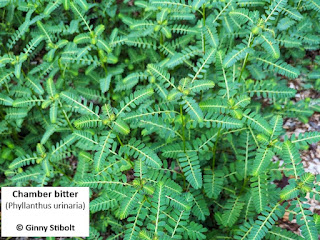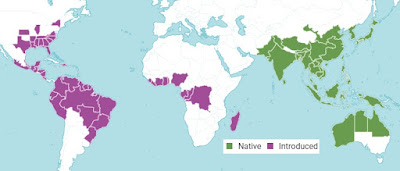 |
| While the sharp, hard spikes on the seeds hurt our feet and embed themselves in the lawnmower tires, this is their method of dispersal. |
Sand spurs
Six species of sand spurs or sandburs (Cenchrus spp.) are native to Florida. They are true grasses in the grass family, Poaceae. While native plants are highly recommended for sustainable, climate-wise landscapes, these are not desirable because of the hard and very sharp prickles that cover their seeds.
They have volunteered in our yard only out by the road where the other plants in our freedom lawn are a bit more sparse and where the neighborhood dog walkers visit on a regular basis. So even though I have cleared out this population of annual plants before, new ones can get a start out there when dogs bring more seeds from elsewhere.
 |
| A bouquet of sandspurs. |
The strategy to clean out a population is to pull as much of the plant out as possible before the seeds fall off or get carried away. We walk by this area of the yard each morning, so I start looking for them in mid summer.
When I see them, I put on my leather gloves and pull out as much as possible and then wait a week or so to pull out more. The plants radiate outward from a central spot and the stems are brown at the center, so they are fairly easy to recognize even when they are not blooming. Since they are annuals, if you get them all, then that should greatly reduce the local population, but I assume they'll be back again in the future.
Phaon crescent (Phyciodes phaon) butterfly's range is eastern North America including Florida and its larval host plants include fogfruit (Phyla nodiflora), so the one that was resting on the sandspur should find plenty of other places to rest.Green Dean says they are edible. And even though you can roast them and also use them to make beer, I am not tempted to try them in any way, but maybe this is one way to take out your revenge on this weed.
 |
| The sandspur range. I have to wonder if it was taken to other parts of the world on purpose. |
 |
| This is a typical growth pattern where there is disturbed soil. |
Chamber bitter
Chamber bitter (Phyllanthus urinaria) is an aggressive weed from Asia in my vegetable gardens and other gardens where the soil has been disturbed. It is a prolific reseeder and the seeds can remain dormant for years, but as soon as they are exposed to light, they germinate. It does occur in my freedom lawn, but since that soil is not disturbed it's not usually a problem there and in my opinion needs no treatment, but I'd be happier if it would stay out of my gardens.
 |
| Even though I'd added woodchips on top of the soil, it wasn't thick enough to prevent an infestation. |
I recently had an invasion of this weed after we had taken out the foundation hedge plants this spring. I'd covered the bed with a layer of wood chips, but it obviously was not thick enough and then we were out of town for a few weeks. The chamber bitter settled in. So out they came and more chips went in, but I'll need a few more sessions before they are better controlled. My plan is to plant bunches of muhly grass (Mulenbergia capillaris) in that space, which will never outgrow its space.
Even though this is a bothersome weed for gardeners and for farmers, it is not listed as an invasive species by the Florida Invasive Species Council, because it has not caused significant damage to natural areas.
 |
 |
| I work at not letting them get this mature. | There are hundreds of flower/seed balls that hang down from under the leaves. |
 |
| The chamber bitter is an Asian/Australian native, which was used as a medicine. |
This plant may ave been imported to the Americas and elsewhere because it was used as a medicine, especially for urinary problems and to break up kidney stones, but it may also have been imported as dormant seeds with other nursery stock. Quite likely, it was a combination of events.
Phyllanthus spp.
There are 13 species of Phyllanthus that occur in Florida including the chamber bitter. Five are Florida natives, while the others are nonnatives. The Florida Plant Atlas genus page has descriptions and photos and the genus page includes a key so you can identify those that you might have in your yard.
One more note: Both of these weeds and many others occur in our freedom lawn and as much as I have promoted freedom lawns, the spread of a few of the more weedy plants is one downside. Freedom lawns are free from pesticides, free from overwatering, free from sythetic fertilizers, free from over-seeding, free from over-mowing, and are better for our families and better for the environment.
Green Gardening Matters,
Ginny Stibolt



No comments:
Post a Comment